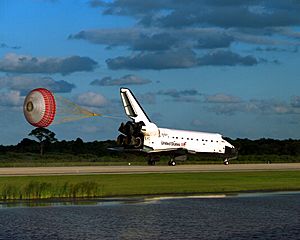STS-86 facts for kids

View of Mir from Atlantis, with damage to one of Spektr's solar arrays visible
|
|
| Mission type | Shuttle-Mir |
|---|---|
| Operator | NASA |
| Mission duration | 10 days, 19 hours, 22 minutes, 12 seconds |
| Distance travelled | 7,000,000 kilometres (4,300,000 mi) |
| Orbits completed | 170 |
| Spacecraft properties | |
| Spacecraft | Space Shuttle Atlantis |
| Landing mass | 114,185 kilograms (251,735 lb) |
| Payload mass | 8,375 kilograms (18,464 lb) |
| Crew | |
| Crew size | 7 |
| Members |
|
| Launching | |
| Landing |
|
| Start of mission | |
| Launch date | 26 September 1997, 02:34:19 UTC |
| Launch site | Kennedy LC-39A |
| End of mission | |
| Landing date | 6 October 1997, 21:55 UTC |
| Landing site | Kennedy SLF Runway 15 |
| Orbital parameters | |
| Reference system | Geocentric |
| Regime | Low Earth |
| Perigee | 354 kilometres (220 mi) |
| Apogee | 381 kilometres (237 mi) |
| Inclination | 51.6 degrees |
| Period | 91.9 min |
| Docking with Mir | |
| Docking port | SO starboard |
| Docking date | 27 September 1997, 19:58 UTC |
| Undocking date | 3 October 1997, 17:28:15 UTC |
| Time docked | 5 days, 21 hours, 30 minutes 15 seconds |
  Left to right – Front row: Bloomfield, Wetherbee, Lawrence; Back row: Chrétien, Parazynski, Titov, Foale. Wolf was not assigned to the mission at the time of this photo |
|
STS-86 was a Space Shuttle mission using the orbiter Atlantis. This mission was part of the Shuttle-Mir program, where American space shuttles visited the Russian Mir space station. It was the seventh time a Space Shuttle docked with Mir.
This flight was the last Atlantis mission before the shuttle went into a temporary break for important maintenance. During this break, Atlantis received upgrades, including a new "glass cockpit" with modern digital displays.
Contents
Meet the Astronauts: STS-86 Crew
The STS-86 mission had a crew of seven astronauts. They were responsible for flying the shuttle, performing a spacewalk, and exchanging crew members with the Mir space station.
| Position | Launching Astronaut | Landing Astronaut |
|---|---|---|
| Commander | Fourth spaceflight |
|
| Pilot | First spaceflight |
|
| Mission Specialist 1 | Fourth and last spaceflight |
|
| Mission Specialist 2 | Second spaceflight |
|
| Mission Specialist 3 | Third and last spaceflight |
|
| Mission Specialist 4 | Second spaceflight |
|
| Mission Specialist 5 | EO-24 Second spaceflight |
EO-24 Fourth spaceflight |
| Originally, Wendy Lawrence was planned to replace C. Michael Foale on Mir. However, because of the size limits of the Russian Orlan space suits, David Wolf took her place. Wolf was also scheduled to fly on a later mission, STS-89. | ||
Spacewalk Details
One important part of the mission was a spacewalk, also known as an Extravehicular Activity (EVA).
- Astronauts: Scott E. Parazynski and Vladimir G. Titov
- Spacewalk Start: 1 October 1997 – 17:29 UTC
- Spacewalk End: 1 October 1997 – 22:30 UTC
- Duration: 5 hours, 01 minutes
Mission Goals and Achievements
The STS-86 mission lasted 10 days. Its main goals included docking with the Mir space station, transferring supplies, and exchanging astronauts. This mission continued the presence of a U.S. astronaut living on the Russian space station.
Docking with Mir
Atlantis carried a special module called SPACEHAB. This module held cargo for the Mir space station. The shuttle docked with Mir on September 27, 1997. The two spacecraft remained connected for five days.
Astronaut Exchange
A key part of the mission was the exchange of astronauts. David A. Wolf traveled to Mir to replace C. Michael Foale. Foale had been living on Mir for 145 days. This made his space flight the second longest for a U.S. astronaut at that time.
Foale's time on Mir had been challenging. Earlier, a supply ship had collided with Mir's Spektr module. This caused damage to a radiator and solar panels. The crew had to seal off the Spektr module. This meant some of Foale's personal items and science experiments were left inside.
Repairing Mir
Russian cosmonauts had already performed spacewalks to deal with the Spektr module's damage. They reconnected power cables from the solar arrays. They also tried to find the exact spot where the module's hull was damaged.
First Joint Spacewalk
Scott Parazynski and Vladimir Titov performed the first joint U.S.-Russian spacewalk during a Space Shuttle mission. This spacewalk lasted just over five hours.
During their spacewalk, they attached a 121-pound (55 kg) Solar Array Cap to Mir's docking module. This cap was for future use by Mir crew members. It could help seal off the suspected leak in Spektr's hull. They also collected four Mir Environmental Effects Payloads (MEEPS) from outside Mir. These devices helped study the space environment around the station.
Cargo Transfer and Experiments
While docked, the crews transferred over four tons of supplies to Mir. This included water, experiment equipment, and spare parts. They also brought back experiment samples and old equipment to Earth.
After undocking, Atlantis flew around Mir. This allowed the crew to visually inspect the station. They looked for any signs of damage or leaks.
Several scientific experiments were also conducted during the mission. These included studies on protein crystal growth and cosmic radiation. Two educational programs, "Seeds in Space-II" and "KidSat," were also part of the mission.
Images for kids








